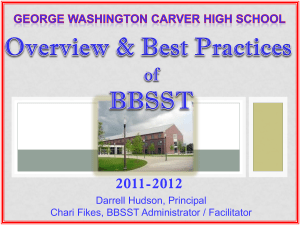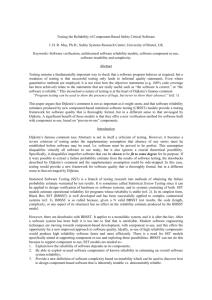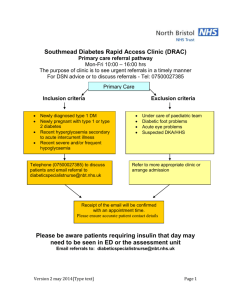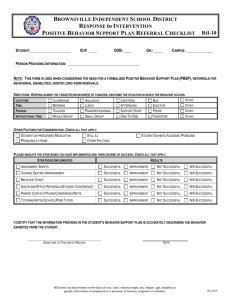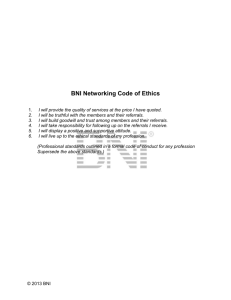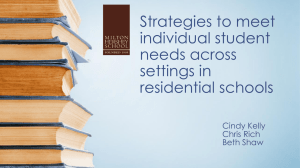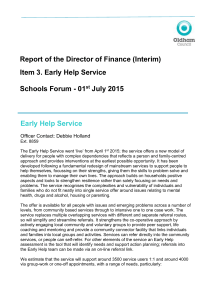Presentation
advertisement
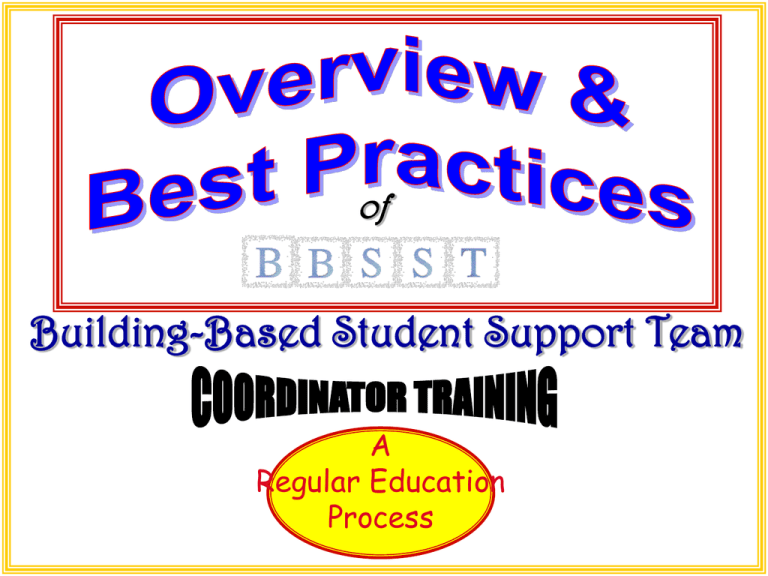
of Building-Based Student Support Team A Regular Education Process Ceceilia Mills Beth Thompson -Your BBSST TEAM – PREVENTION AND SUPPORT SERVICES TELEPHONE: (334) 242-8165 FAX: (334) 353-5962 E-MAILS: cmills@alsde.edu bthompson@alsde.edu Guidelines and Goals of CONCERNS • Discipline & Drop-outs • Individual needs/challenges • Referrals to special education • Time & Energy Why BBSST? • Purpose for students? •Purpose for staff? • Indicators of At-Risk Students? •Benefits? •Mandated or voluntary? •What’s working? •What’s not working? LEE v. MACON Mandatory • • Lee v. Macon Consent Decree, Prereferral Process, pgs. 4-7 Ala. Admin. Code § 290-8-9-.1-.72ER(2) Student • • • • BBSST Teams Prereferral Form & Tracking Log State-mandated forms as of December 1, 2000 Distributed in hard copy Can be downloaded from the website Ends March 15 yearly & due electronically to SDE April 1 BBSST training required for all certified personnel with yearly updates. 8,000 6,502 6,000 4,076 3,786 4,000 2,909 2,426 2,326 1,460 2,000 877 372 505 0 Black A Students Referred for BBSST Services White A Total A Black B Students Referred on for SP ED1 Eval White B Total B Students Eligible for SP ED Services Students Ineligible for SP ED Services Black C Total C White C Total D 43,418 44,000 42,000 40,000 38,000 36,000 34,000 32,000 30,000 28,000 26,000 24,000 22,000 20,000 18,000 16,000 14,000 12,000 10,000 8,000 6,000 4,000 2,000 0 Black A 22,896 20,522 12,500 9035 5,789 6,711 3465 1399 Students Referred for BBSST Services White A Total A Black B Students Referred on for SP ED1 Eval White B Total B 2066 Students Eligible for SP ED Services Black C White C Students Ineligible for SP ED Services Total C Total D BBSST Definition A designated schoolbased committee designed to meet the needs of general education at-risk students. State At-Risk definition on pg. 38 of BBSST manual Teamwork (synergizing) is a process Collaboration centers around the concept that everyone’s combined ideas can be greater than just one person’s idea. What is the T.E.A.M. Approach? Working cooperatively with classroom teachers, special education facilitator, administrators, parents and students— Together Everyone Achieves More BBSST is not a guarantee of Promotion Making the honor roll Passing the graduation exam Higher SAT scores What BBSST can be is a guarantee that a student will be given every consideration & accommodation that your staff can offer as an opportunity for success. REFERRALS Why refer a student? Academic Behavioral is NOT used for or Or any other class of “CHOICE” IS used for ANY class that counts toward graduation credit Active 504 or IEP students NEVER go to BBSST ! BBSST Teams are not 504, IEP, or ESL Teams What about students that exit special education? •Special education case manager that exits the stude into general education makes referral to BBSST. •Case manager meets with the team, including general education teacher, to write plan based on most recent IEP needs. •The plan does not include modifications from IEP, it shapes those into regular classroom strategies that taper off over 6 or more weeks. •General education teacher implements plan and reports progress back to BBSST team at the end. FOLDERS Become part of student records at withdrawal or transfer - send most recent (3-page) prereferral form only Archive old 3-pg. plans only – discard attachments, etc. LEA COORDINATOR RESPONSIBILITIES Implements all local BBSST training. Provides training for new teachers and new team members. Provides yearly updates for principals each year. Provides ongoing training opportunities for teachers, administrators, and parents. Monitors implementation at the school level. LEA COORDINATOR Monitor of Schools Probably good idea to keep individual school files Tracking log information (hard copy) Team minutes/Sign-in sheets or 1-pg. yearly summary (like fire drills) List of team members & job assignments Parent notification information Sign-in sheets from Central Office trainings Principals’ written monitor information New Teacher training sign-in sheet Annual Principal update training sign-in sheet LOOK AT MONITOR SHEET Questions about… TEAM MEMBERS Regular members: Administrator Teacher requesting support Regular Educators Guidance Counselor Auxiliary (by invitation) members: Title I Teacher Parents Special Educators Paraprofessionals Central Office Staff Nurse Other Agency Representative TEAM RESPONSIBILITIES Set regularly scheduled meeting times at beginning of year Set cut off time (1-2 days) before meeting for completed teacher form to be in Schedule the referral meeting as quickly as possible Encourage & support referring teacher Clarify or prioritize reason for referral Provide solutions & strategies Write plans Re-meet to evaluate success after every plan Make decisions about need for future plans The Principal is the Key! As goes the principal, so goes the school. PRINCIPAL RESPONSIBILITIES Attends all meetings (active team member) Determines the team make-up (not randomly selected, chosen for diverse experience & expertise) Appoints a facilitator or co-facilitators Approves a meeting time & arranges schedule - (preferably during the school day for staff coordination) & then turns it over to the facilitator Supports (insures) interventions and/or strategies being implemented by contact with the teacher Establishes confidentiality policy Arranges time (schedule) for facilitator’s preparation Encourages teachers to make referrals IDEAS for Principal’s Documentation Use pg. 2 of referral form “Log” sheet like fire drill sheet Create a form of your own or a system-wide form 3 x 5 card file Lesson plans indicator (make a copy) Set up a time during plan for teacher to check in with you with their written documentation of implementation (from pg. 2) Think out of the box. IDEAS for Principals or Coordinators A quick check – one easy way to determine whether your school/system is making appropriate referrals Compare the tracking log names to: Progress report names Report card grades of “D” or “F” Discipline referrals to office (book or list) Projected retention list Retention list Choosing your team members Building A Strong Committee Administrators Title I Facilitators Teachers who know the students Teachers who are efficient in problem solving Teachers dedicated to changing lives Support Group Counselors Special education educators Parents FACILITATOR RESPONSIBILITIES (A general education classroom teacher, cannot be a special education teacher.) Schedules meetings Receives student’s names in advance Prepares agenda for meetings Stores data for documentation Facilitates/leads in team discussion We recommend co-facilitators RECORDER RESPONSIBILITIES Records the meeting notes & minutes. Records information on pg 2 of each student’s intervention plan during the meeting. Lists extra suggested strategies for students’ files. Writes down plans for unresolved issues. Shares the responsibility of completing the tracking log with the Facilitator. REFERRING TEACHER RESPONSIBILITIES Makes request for support & provides information on pg. 1 of referral form for a complete picture: Cumulative records summary page (copy) Work samples Assessment records Behavior info: office referrals, behavior checklist, discipline letters sent home, past behavior contracts, etc. Attempted interventions & results Interaction with parents Work Samples for Teachers to attach: 1. Teacher-led activity 2. Independent activity 3. Homework or paper with excuse & signature 4. Copies of tests Children: 1. 2. 3. Have different backgrounds Learn at different rates Learn in different ways LINGUISTIC: LINGUISTIC learn through reading, writing, telling stories LOGICAL-MATHEMATICAL: MATHEMATICAL learn through logic, patterns, categories, relationships KINESTHETIC: KINESTHETIC learn through hands-on sensations, touching, manipulating SPATIAL: SPATIAL learn through images & pictures MUSICAL: MUSICAL learn through sound & rhythm INTERPERSONAL: INTERPERSONAL learn through interaction & communication with others INTRAPERSONAL: INTRAPERSONAL learn through their own feelings Intelligence Area: Is Strong In: Likes to: Learns Best Through: Famous Examples: Common Misbehaviors: Verbal/ Linguistic Reading, writing, telling stories, memorizing dates, thinking in words Read, write, tell stories, talk, memorize, do word puzzles Reading, hearing, and seeing words; speaking; writing; discussions T.S. Eliot, Maya Angelou, Abraham Lincoln Passing notes, reading during lessons Logical/ Mathematical Math, reasoning, logic, problem-solving, patterns Solve problems, question, reason, work with numbers, experiment, use computers Working with patterns and relationships, classifying, abstract thinking Albert Einstein, John Dewey, Susanne Langer Working on math or building things during lessons Reading, maps, charts, drawing, puzzles, imagining things, visualization Design, draw, build, create, daydream, look at pictures Working with pictures and colors, visualizing, drawing Pablo Picasso, Frank Lloyd Wright, Georgia O’Keeffe, Bobby Fischer Doodling, drawing, daydreaming Athletics, dancing, acting, crafts, using tools Play sports, dance, move around, touch and talk, use body language Touching, moving, processing knowledge through bodily sensations Charlie Chaplin, Michael Jordan, Martha Graham Fidgeting, wandering around the room Singing, picking up sounds, remembering melodies, rhythms Sing, hum, play an instrument, listen to music Rhythm, melody, singing, listening to music and melodies Leonard Bernstein, Mozart, Ella Fitzgerald Tapping pencil or feet Understanding people, leading, organizing, communicating, resolving conflicts Have friends, talk to people, join groups Sharing, comparing, relating, interviewing, cooperating Mohandas Gandhi, Ronald Reagan, Mother Teresa Talking, passing notes Understanding self, recognizing strengths and weaknesses, setting goals Work alone, reflect, pursue interests Working alone, self-paced projects, reflecting Eleanor Roosevelt, Sigmund Freud, Thomas Merton Conflicting with others Visual/ Spatial Bodily/ Kinesthetic Musical/ Rhythmic Interpersonal/ Social Intrapersonal/ Introspective http://www.learning-styles-online.com/inventory/default.asp?ref=ga&data=learning+styles+free+test#excel www.learning-styles-online.com/inventory/questions.asp?cookieset=y http://www.studyguide.org/learning_styles.htm What is it that we really want the students to do? Study Skills Test Taking Skills Higher Order Thinking Skills Problem Solving Skills Kids aren’t born “instant students”. We can’t assume they know how to act the way we want them to The behavior we want needs to first be taught to them. Just as we teach math skills before we expect them to perform math, so must we teach basic behavior skills before we can expect them to have those skills. We have elaborate curriculum guides for teaching academic skills, but usually have no guide at all for teaching foundational behavior skills. The right thing at the wrong time is still the wrong thing. Accommodations Vs. Modifications What Is the Difference ?? ACCOMMODATIONS are adjustments made to enhance a student’s participation (increase success) in an activity without a change in course content. These would be changes in presentation and/or the evaluation. MAY BE PROVIDED THROUGH BBSST MODIFICATIONS are changes made to course content and/or grade level. PROVIDED THROUGH THE SPECIAL EDUCATION PROCESS *Alabama Course of Study cannot be cut. How Long? Give intervention 6-9 weeks (30-45 class days)…… If it is not helping the studentthere’s absolutely no change after 2 weeks, change it. If the team decides that the student needs additional an ‘formal’ BBSST plan monitored by the team at the end of the 30-45 days: Complete pg. 3 to close out this plan. •Enter the name on the log again. •New pg. 1 OR •Adjust pg.1with current averages & any new information (use different ink color). •Team completes a new pg. 2 (new strategies). •Teacher implements plan for another 30-45 days. •Team reconvenes at the plan end to discuss Don’t “wait” too“late” to utilize the BBSST process. Half-way through the class (final credit) is a good checkpoint. The end of the year (or credit) is TOO LATE to help the student!! •No isolation of strategy, use multiple ideas •Strategies can be changed during plan or in subsequent plans •Use concepts – not “whole” subjects or grade levels What about parent referrals? •BBSST first ideally •Run simultaneously otherwise •Teachers follow same process for parent referral as if they made the referral •Teacher still completes pg. 1, meets with team, implements strategies •To bypass BBSST, must have acceptable •Written documentation of a behavioral condition or academic disability that seriously affects school performance. Has to originate from an acceptable source, i.e.: *a good behavior source – psychiatrist *a good academic source – testing by a valid institution or agency Review of BBSST Action Teacher directed Average of 2 weeks - (10 classroom days) before referral Team directed Team meets every month Plan directed 6 weeks minimum-(30 classroom days) 9 week maximum until review Recommendations Follow-up meeting after every plan Questions about the BBSST forms? How do I download the forms? Page 1: •Completed by the teacher of the class that the student is having academic or behavioral difficulties in. •This page is given to the Team Facilitator in advance of the monthly meeting. Page 2: •Completed by the BBSST team the 1st time they meet on this student. •A copy of this page is given to the teacher to implement the next day. Page 3: •Completed by the BBSST team when they meet on this student at the end of the 30-45 day plan to evaluate it’s effectiveness. •Everyone on the team signs this page. What about the TRACKING LOG and MENU? Logs end every year on March 15. Tracking Log year runs from March 16 of each year to March 15 of the next year. March 15 is the only day that “Outcome 4 - Pending” is used from the menu. Questions & Answers Monitoring Questions Suggestions for Parent Information Dissemination •Student Handbook or System Handbook •Handout at Open House •Letter or Memo home •Newspaper ad •Website posting •PTO / PTA Agenda •Pamphlets in front office •Parent Training at School •School Newspaper or Newsletter Recommended Resources for Strategies The BBSST Manual has information on: Summary Student reports Incident Report Dropout Data Suspension/Expulsion Kids Count Data (At-Risk info.) IDEA 504 Rehabilitation Act Resources for strategies www.alex.state.al.us www.avl.lib.al.us www.nea.org/tips/library.html http://www.alsde.edu/sig/initiatives/behavior.html http://www.pbis.org/main.htm Donna Kirkendoll (334)242-8114 http://iris.peabody.vanderbilt.edu/ http://iris.peabody.vanderbilt.edu/webdirectory.html CD in every LEA provided by SDE CD in every LEA provided by SDE * NEW * For training contact: Theresa Farmer tfarmer@alsde.edu 334-242-8114 Menu Page For training contact: Theresa Farmer tfarmer@alsde.edu 334-242-8114 Alabama Public Library Service 334-213-3900 1-800-723-8459 Team Organization & Operation Ideas from across the state “Give a man a fish, you feed him for the day. Teach him how to fish, you feed him for a lifetime.” BBSST to the Rescue! Helping Teachers Makes teachers more aware of intervention strategy options (good teaching practices) Helps with vertical communication Helps teachers correctly identify students who need resource assistance Helps the teacher to address learning styles through teaching styles Responsibility & expertise shared among school staff BBSST to the Rescue! Helping Students Ideas and strategies Individual student attention Increases opportunities for student success and improvement Reduces student & teacher stress Addresses “slipping through the cracks” BBSST to the Rescue! Helping Parents Increases positive interactions between parents and teachers Increases Shows sources of communication parents that students are receiving individual attention How to Have a Better Meeting Everyone has a copy of Stay focused on current the instructional strategies students……do not chase and other vital rabbits or conduct a gripe information. session. Set agenda with “time slots” and have a time keeper. Assign each person a job to do: computer person, time keeper, minutes taker, materials gatherer… Provide training for team members and update annually. Food always helps! Follow-Up Meetings Discuss initial follow-up meeting. Assign new interventions, monitor progress, release the teacher, etc. After 2 or 3 plans of unsuccessful interventions, referrals to other programs may be appropriate. DOCUMENTATION !! What We’ve Learned/ What Has Worked Scheduling meetings during the work day are more effective Time management is the key to success The seriousness of BBSST Keeping a good paperwork trail Meeting even if there are no new referrals Reduction in special education referrals Communicating through collaboration BBSST & Faculty working together for team success Better discipline overall Importance of adequate training & updates of team & More of What Has Worked from MEGA Conference Development of additional teaching strategies, benefiting all students. Helps transition as students move to next grade. Regularly scheduled meetings . Permanent core team members. Floating substitutes. Paperwork & attachments completed properly and on time. Agenda prepared & distributed ahead of time. Addressing major problems first – A.S.A.P. Consistent monthly meeting & additional meetings if needed. Create sub-committees. Provide substitutes for team members & meet during the day. More of What Has Worked from MEGA Conference Laptop or computer available in meetings for forms & minutes. Incentives to serve on team; I.e., duty free lunch, relieve facilitator from additional school responsibilities to lead BBSST effectively. Stay on time when meeting. Release time for teachers. Use of a timer to monitor amount of time used to discuss each student. Refresher staff development on BBSST yearly. Schedule meetings according to grade level. Guidelines for teachers on “when to refer”. Teachers informed of the implications of referring & not referring. Supply teachers with a BBSST packet & checklist at beginning of school year. What Didn’t Work What Didn’t Work Meeting at busy times of the year such as during SAT 10 Testing and Writing Assessment Waiting until the last 9 weeks of school to refer students to BBSST Having “marathon” meetings after school Allowing teachers to send referrals ‘last minute’ and/or accepting incomplete information on the form Suggestions for Future Plans for your Team Sheet to be placed in permanent record folder for BBSST students Appointing a Co-Facilitator Being just as successful as we are in making sure “No Child Is Left Behind!” Beginning of year have principal review staff on: the form, the team members, facilitator, meeting schedule (at minimum) 1. Accept pre-referral names from various sources: Administrator, teachers, counselors, or parents 6. Optional: Contact parents and inform them of team’s decision to monitor student 7. Give teachers intervention plans for students and begin the 6-week process of intervention strategies and documentation of process 2. Have teachers complete page 1 of the pre-referral form 5. Determine intervention strategies for all students in BBSST meeting and prepare plan pages (pg. 2 of form) 8. Update administrator on progress of students. Gather all monitoring sheets and update student files at the end of the intervention period 3. Teachers gather all background information for students being referred 4. Organize BBSST meeting and present prereferrals to the committee 9. Schedule committee meeting and present findings. Determine the next course of action for each student and begin new interventions for continuing students and new referrals Getting Your Faculty Onboard! 1. 2. 3. Involve everyone from the beginning and all throughout the process! Have a staff overview of the “whole picture” process. Have yearly updates at the beginning of each year. Getting Your Faculty Onboard! Get their attention! Be positive! Avoid negative comments and actions. Share success stories. Give extra attention to new faculty members. Invite questions. BBSST Challenges/Solutions Challenge Solution Paperwork Meeting time Follow-through Gathering work samples (4 kinds) Record as you go! Do it electronically! During day using Substitutes for teachers Professional Development and Awareness Sessions, Targeted Topics One on one contact with teachers One school’s solution -- How and When We Meet During lunch period usually between 1112:30 Meetings are held once a week on Wednesday during the 1st semester, and twice a month second semester for new referrals/follow-ups. Principal, Central office, or PTO can provide funds to hire substitute teachers. BBSST Challenges/Solutions Challenge: Solution: Understanding the Process Overview Sessions with Faculty at Beginning of Year Updates as needed Targeted Topics in professional development Principal Leadership Leadership at all levels Training, Training, Training Accessible Forms Timely Response to Faculty Concerns Good Teaching Practices Practical Applications What is working for your team? What is working for other teams? What is not working? What do you know about effective practices in other schools & systems? What would you like to know about other teams in the state? PRACTICAL APPLICATIONS What does this term mean to you? What exactly is differentiation ? Good Question . . . Differentiating instruction is a philosophy that enables educators to strategically plan in order to reach the many diverse needs of each student in today’s classrooms. What Can Be Differentiated? Instructional Strategies Classroom Atmosphere Activities Performance Tasks Evaluation/Assessment Tools Climate Knowing the Learner Assessment Adjustable Assignments Instructional Strategies Curriculum Approaches Nurturing Safe Stimulating Challenging Collaborative Multi-Sensory Encourages Risk-Taking Climate 7 Habits of Highly Effective People Discipline Workshops Classroom Management Workshops At-Risk Students Workshops Knowing the Learner Observing Students Multiple Intelligences Learning Styles Journals Inventories Cumm. Folder Info Talking to Parents Learning Styles. . .What are they? What do you do when you learn something new? Approach the task in a similar fashion each time Over time you have developed a pattern of behavior that you use for new learning This Pattern Is Called A Learning Style Identifying & Understanding Styles Observe - Patterns of behavior - What brings about success? Listen - To the way a person communicates Experiment - With what works & what does not Focus - On natural strengths, not weaknesses Learn - More about learning styles in general What Kind Of Learner ? Auditory – Learns by listening to verbal instructions; remembering by Visual – Learns by seeing & watching; uses strong visual associations Tactile/Kinesthetic – Learns by being physically involved; is actually forming the sounds of words doing something with what is being learned Auditory Learner Strategies for Class & Home - Offer to drill verbally (Teacher, family, classmate, friend) - Help put information into rhythmic pattern (Song, poem, rap) - Reading assignments: Let them read aloud; Tape the reading, then play back for review - Minimize visual distractions Visual Learner Strategies - Give bright colors & large spaces to work - Encourage them to take notes or doodle while listening - Stress underlining & highlighting information in notes or books when possible Tactile-Kinesthetic Learner Strategies - Encourage them to take frequent breaks - Offer big spaces to work - Provide stories to read that are action filled - Instruct them to write notes or highlight information while listening Identifying “Teacher Style” Students Need To Identify Teachers’ Dominant Learning Style/Teaching Style Too !! Classroom Environment Classroom Organization/Management Attitude Toward Students Teaching the Course Content Teaching Modalities/Aids Grading Practices How Many Ways Can We Be Smart? Linguistic Logical-Mathematical Spatial Musical Bodily-Kinesthetic Interpersonal Intrapersonal Assessment Pre-Assessment Formal Informal Post-Assessment Getting The Best Of The Test ! Test Tips For Analytics (Those who like detail, focus, organization, specifics, direct answers, specifics, consistency, one thing at a time !!) Scan test to see how many essays, multiple choice, or true/false you have to answer. Divide time accordingly. Do easy questions first, then come back to complex questions. Keep test area free of clutter. Have an extra pen or pencil available. Getting The Best Of The Test ! Test Tips For Globals (Those who see the “big picture”, flexible, goes with the flow, skips steps/details, cooperates in groups, learns by discussion!!) Dress comfortably. Eat something before the test. After studying, get together with small group of classmates & review by testing each other. Do not arrive early to class. Last minute cramming may be confusing. INSTRUCTIONAL STRATEGIES Brain/Research-Based - Focus Activities - Graphic Organizers - Metaphors - Role Play Adjustable Assignments Independent Paired Small Groups Large Group Flexible Grouping Designs Knowledge-Based Groups Interest Groups Cooperative Learning Groups Project Groups Ability Groups Random Groups Multi-age Groups Peer-to-Peer Tutoring In A Nutshell No single test can measure or predict a person’s intelligence. Everyone can win when given a chance to show how they are smart. The acceptance of a theory about multiple intelligences helps us value the differences among various cultures. Cynthia U. Tobias, The Way They Learn @1994. Curriculum Approaches Centers Problem-Based Contracts/Agendas Inquiry Projects Think About Classroom Management Basic Beliefs - Classroom organization has enormous impact on behavior - Overtly teach students responsibility in every classroom situation - Pre-plan responses to misbehavior CHAMP C = CONVERSATION H = HELP A = ACTIVITY M = MOVEMENT P = PARTICIPATION C = Conversation Can students talk to each other during this activity/transition ? H = Help How How can students get questions answered during this activity/transition ? do they get your attention ? A = Activity What is the task/objective of this activity/transition ? What is the expected end product ? M = Movement Can For students move about during this activity ? example, are they allowed to get up to sharpen a pencil ? P = Participation What does appropriate student work behavior for this activity/transition look/sound like ? How do students show that they are fully participating ? Self Assessment Checklist Long-Range Classroom Goals Guidelines for Success Positive Expectations Level of Classroom Structure Daily Schedule Physical Space Attention Signal Classroom Rules Classroom Management Plan Checklist (continued) Student Work Expectations for Classroom Activities Expectations for Transitions Lessons to Communicate Expectations Day One Enthusiasm Effective Instruction Non-contingent Attention Positive Feedback Intermittent Celebrations T-CHARTS What Should It Look Like ? What Should It Sound Like ? Expectations for Teacher Directed Instructions & Discussions LOOKS LIKE -Eyes on speaker, overhead, or notes -Everyone looks like they are listening -Hands raised before speaking -Notes being taken -Everyone seated, except speaker -If someone disagrees, hand is raised SOUNDS LIKE -Only one voice at a time is heard -Presentation voice used when you are the speaker -?s & comments from speaker are lesson related -No noise during note-taking if you are not speaker -All verbal participation sounds respectful Questions for Parents Where should your child study? How quiet should it be? What about light? Should you turn up the heat/cool air? Should children be allowed to eat while studying? ANSWERS It Depends On Your Child & Their Learning Style !! Other Home Study Tips Listen to the internal time clock Have your student (or child) describe the ideal study spot Try an experiment for getting your student (or child) to do homework - For two weeks agree to let your student (or child) study at home any time, any place, with anything they say they need !! - For best results, contact the parent (or teacher) & discuss prior to implementing to determine whether work improves during the trial period What can you do this year to make your BBSST more effective? What creative BBSST ideas can you share? What now? How can this work for you? Can you integrate these ideas into your team habits? Will this enhance learning or improve behavior in your school? “A pessimist looks for difficulty in the opportunity, but an optimist looks for opportunity in the difficulty.”
